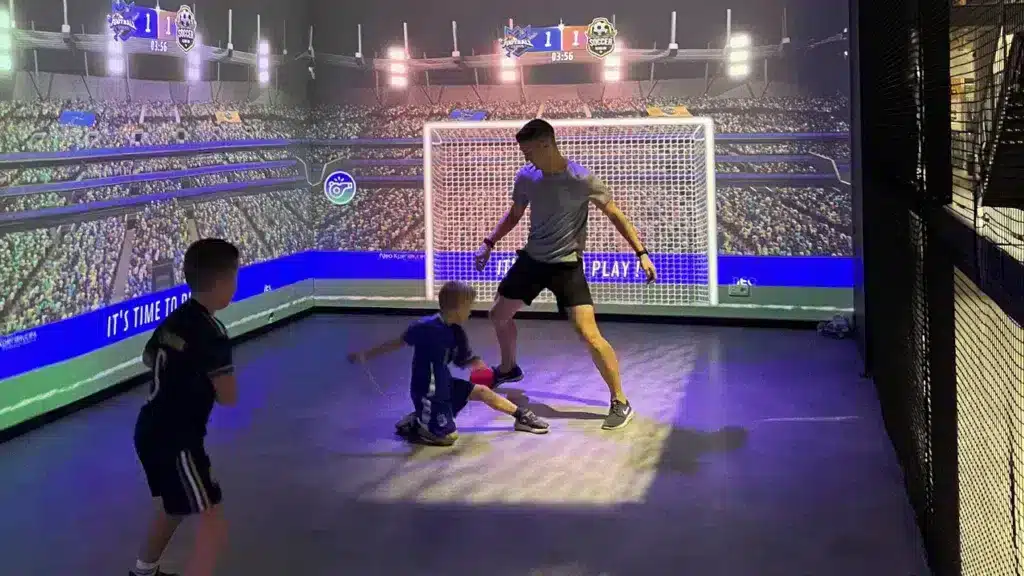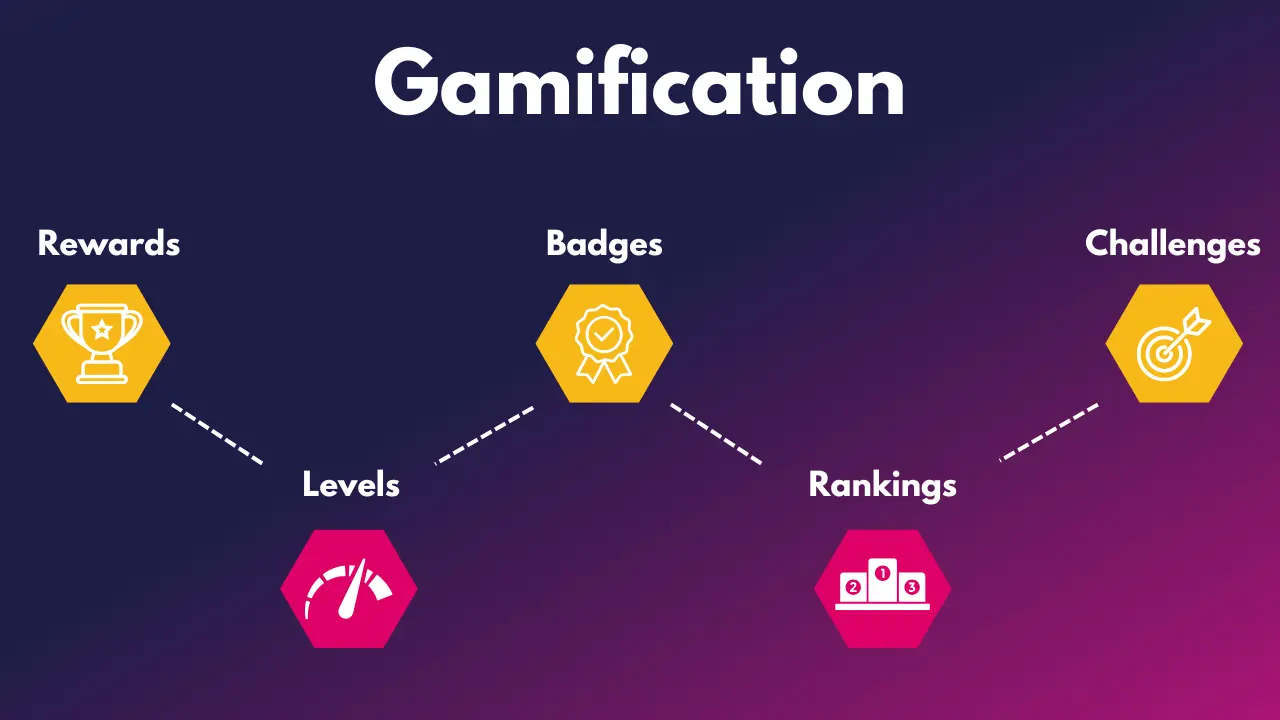
What is gamification for education?
Gamification is a method that borrows concepts from games and integrates them into serious contexts, such as education, to increase engagement.
What does this mean in practical terms?
It means transforming a traditional lesson into a much more engaging adventure, with levels to complete, badges to unlock, points to earn and sometimes even missions to accomplish as a team! Whether alone or in a team, it’s a bit like imagining students playing a video game, but learning without even realising it sometimes.
But be careful, gamification isn’t just about ‘making school more fun.’ Its real purpose is much greater. It is above all a method of stimulating students’ intrinsic motivation. The aim is to get them actively involved in what they are doing and help them remember what they learn better. Thanks in particular to clear objectives, immediate feedback and a dynamic environment, this educational method is perfectly suited to the expectations of generations that have grown up with digital technology.
Today, with the rise of technology, gamification is finding its way into more and more classrooms. And it’s not just a trend: several studies show that, when well designed, it improves not only concentration but also academic performance! It changes the way we learn… and often the way students view learning itself.
The evolution of gamification in education (learning through play)
The beginnings: the first educational software (1980s-1990s)
At the end of the 1980s, personal computers became widely available. That was when software such as Lapin Malin (Reader Rabbit), Math Blaster and La Piste de l’Oregon (Oregon Trail) were introduced into American primary schools.
The idea was to teach basic skills through interactive mini-games that worked on a simple loop: question, answer, feedback, and so on.
At that time, game elements were still only tentatively included. However, this laid the foundations for what would later become gamification. Teachers quickly realised the value of these tools, particularly in helping them to maintain the attention of pupils, especially those who struggled with traditional methods.
The rise of CD-ROMs and interactive simulations (1990–2000)
In the 1990s and 2000s, CD-ROMs provided a more advanced experience for users, with better graphics, sound and more content. SimCity (1989), although not originally designed for educational purposes, was adopted by some teachers to teach urban planning, economics and ecology. This game ushered in a new era in which simulations became an educational tool in their own right.
Other titles you are probably familiar with, such as Microsoft Encarta and Adibou, allow children to learn by freely exploring a rich and interactive environment. The very structure of the game begins to shape the learning path through objectives, rewards and levels.

The explosion of the web and online platforms (2000–2010)
Between 2000 and 2010, the Internet changed everything! Access to resources became virtually unlimited.
Platforms such as Cool Math Games and BrainPOP began offering hundreds of educational games online for all ages. The experience was customisable, often free, and accessible from any browser. It was a revolution in accessibility and education!
Students could now learn at their own pace, from the comfort of their own homes. This decade also saw the emergence of the first learning tracking platforms incorporating elements familiar from video games: points, levels, automatic feedback and collective challenges.
Artificial intelligence and adaptive games (2020 to present)
Today, gamification goes far beyond games! Artificial intelligence makes it possible to personalise learning paths according to each student’s level, behaviour or progress. We are therefore seeing the emergence of dedicated platforms such as Duolingo, Khan Academy and Smartick, which use algorithms to adjust the difficulty of exercises in real time.
At the same time, educational games are evolving towards more hybrid experiences:
- With gamified interfaces for homework,
- With a reward system in the form of digital tokens,
- With multi-level progression inspired by RPGs,
- Through social interactions and community challenges.
What trends can we expect to see in gamification in education in 2025 and beyond?
The future of gamification for educational purposes is already taking shape through:
- Augmented reality (AR), which can now transform a classroom into a living museum or virtual laboratory. For example, apps such as Merge EDU now allow users to explore human organs or molecular structures in 3D.
- Virtual reality (VR), which enables unique immersive experiences through VR headsets. This allows students to travel through time, visit the moon or dive into the oceans, for example.
- Generative artificial intelligence, which is the principle of imagining learning scenarios that are designed to adapt in real time to the student’s reactions and evolve based on the responses obtained.
According to HolonIQ, the global educational technology (EdTech) market will reach $404 billion by 2025. This panel highlights that gamification will play a central role in this growth. It is clear that the education of tomorrow will be immersive and more individualised. Tools such as ClassVR, Merge Cube and Quizizz AI already offer augmented experiences.
Imagine:
- A biology student exploring a human heart in VR,
- A history class visiting an ancient battlefield in 3D,
- A teacher generating questions tailored to each student in real time using AI.
All this is no longer the stuff of science fiction. It’s already here, and it’s only just beginning.
Interactive games using the example of NeoXperiences interactive walls
At NeoXperiences, we design interactive walls that immerse students in sensory worlds. Children learn by playing, running and touching. This approach is particularly effective for primary schools, but also for children with special needs. Our games are designed to be inclusive and suitable for everyone, including people with reduced mobility. Take ABAKUS, for example, a maths game that can easily be combined with sport using a team and relay system to reach the correct answer.

Educational escape games
Used in middle schools and high schools, educational escape games promote teamwork and logical thinking. They are an ideal way for subjects such as geography and history to blend reality and fiction. This system encourages collaboration, reflection and, above all, the practical application of knowledge. All you need is a well-written scenario and some puzzles related to the school curriculum, and you’re ready to go! Many teachers create their own escape games using tools such as Genially or Lockee.
The benefits of gamification in education
Commitment and motivation
An engaged student is a student who learns. Through the gamification of education, we encourage active rather than passive learning by increasing emotional, visual and social entry points.
Improved retention
Immediate feedback, repetition and rewards help to anchor knowledge in the long term through positive memorisation of the experience.
Skills development
Problem solving, creativity, critical thinking and collaboration are all soft skills that develop naturally through well-designed games.
The fundamental principles of educational gamification
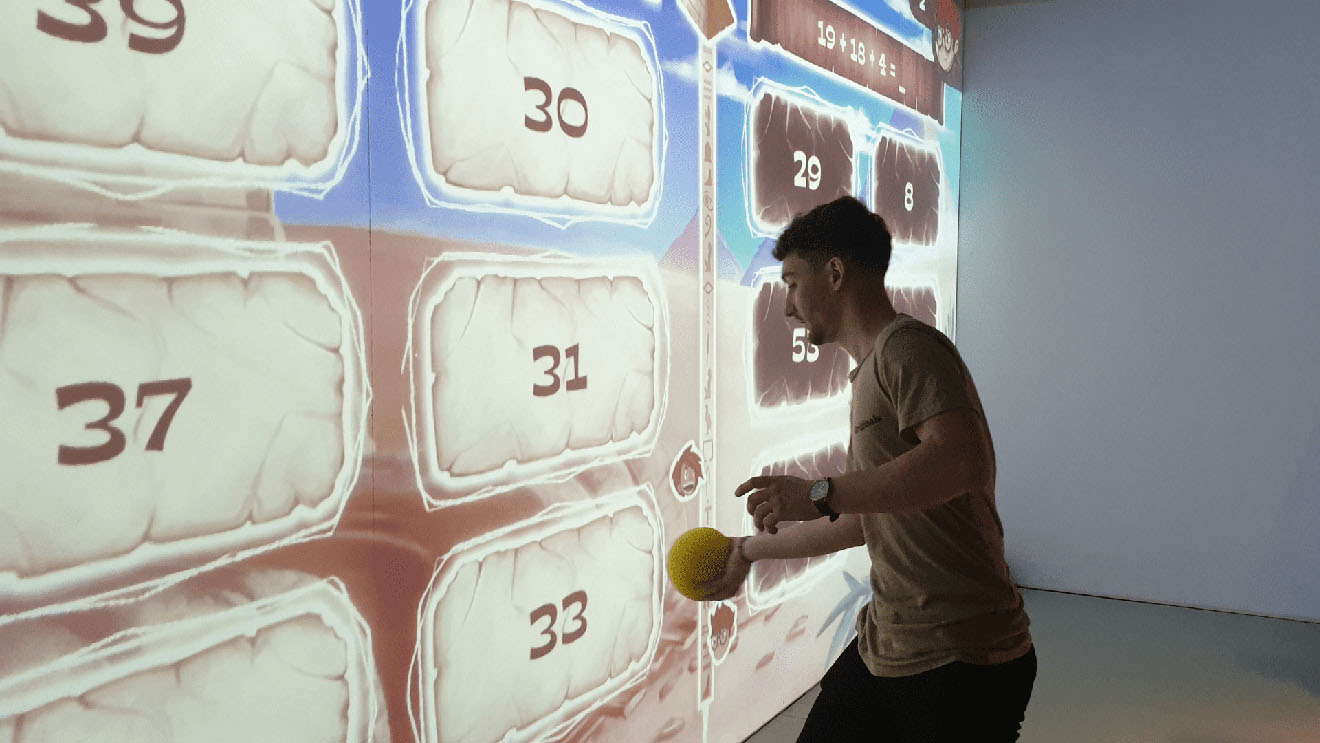
The psychological foundations of gamification
- Intrinsic motivation: this is characterised according to the self-determination model (Deci & Ryan). More specifically, gamification stimulates the fundamental psychological needs of learners:
- Autonomy (choice),
- Competence (appropriate challenges),
- Belonging (social interaction).
- Positive reinforcement: each action is rewarded (visually, audibly or symbolically), which acts as a powerful motivator. Players want to perform the requested action correctly in order to feel the satisfaction of being rewarded.
- The learning curve: good educational games strike a delicate balance between increasing difficulty and regular rewards. This principle helps to maintain students’ motivation without discouraging them.
Game elements applied to learning
- Clear objectives
- Structured progression
- Appropriate challenges
- Immediate feedback
- Integrated repetition
- Sensory immersion
- Social interaction
The fundamental mechanics of educational games

Game mechanics that incorporate gamification are more than just playful gimmicks. They are primarily used to structure learning by setting a pace and clear objectives in order to strengthen student engagement.
XP (experience)
For those in the know, XP in video games, which is equivalent to experience points, is one of the most widespread mechanics. It is a gauge that works according to continuous progression, is easily visible and motivating. More than just a gauge that increases, it concretely reflects effort and commitment to the activity! Indeed, an increase in XP is the direct result of an action being performed correctly.
For example, in an educational context, XP is awarded for specific skills such as maths, grammar, logic, etc. It can also be linked to more cross-cutting skills such as collaboration, creativity and perseverance. By taking several aspects into account, it is possible to accurately visualise progress in different established categories. Beyond that, experience points greatly promote a positive dynamic of continuous improvement by building on individual or collective progress, but without comparison with others.
Badges
Badges are a reward system that works like a digital certificate. They reward achievements, which can be multiple:
- Acquisition of a skill,
- Completion of challenges
- Participation in projects.
A badge can recognise a one-off achievement or regular behaviour, such as actively participating in class for a month.
More and more schools and institutions are adopting open badges. These are verifiable digital badges that can track learners throughout their educational lives. If they are official, these distinctions can be included in portfolios, LinkedIn profiles or job applications. This provides concrete recognition of a person’s informal or extracurricular achievements.
Rankings
Rankings, or more commonly known as leaderboards in video games, allow learners to see where they stand in a competitive or cooperative environment. Used correctly, this reinforces motivation by creating a healthy group dynamic and competition that rewards sustained effort.
However, be careful to use this tool sparingly and with caution. The aim should not be to overwhelm certain people and single out the ‘best’ at the expense of others. Personalised or collective rankings should be offered to encourage individual progress, challenges between teams or the achievement of common goals. For example, a good ranking rewards progress and self-improvement, not pure and unhealthy competition.
Levels and progression
Progression levels are essential. They allow learning to be structured in a progressive manner. They give students the opportunity to unlock content as they succeed. This encourages a step-by-step approach, where each level achieved becomes a reward in itself, but also a lever for curiosity: ‘What will I discover next?’
This mechanism gives students a sense of control over the experience! It reassures them by providing clear benchmarks, while maintaining their attention and motivation thanks to a well-balanced increase in complexity. More specifically, levels can be linked to themes (level 1: basics of geometry, level 2: complex shapes) or activity formats (level 1: quizzes, level 2: collaborative projects).
Quests and narrative scenarios
One of the great strengths of gamification is its ability to tell a story. Through quests and scenarios inspired by role-playing games, it makes educational activities more concrete. Imagine, instead of doing a traditional exercise, you have to complete a mission, save someone or solve a puzzle… In short, it becomes a much more stimulating and engaging exercise for the person experiencing it.
This storytelling transforms the learning experience by stimulating the imagination, thanks to a clear objective. In a quest, mistakes are no longer failures, but natural steps along the way. It’s an excellent way to reconcile students with mistakes and to value experimentation and, above all, perseverance.
Visual and audible feedback
Visual and audio effects reinforce the emotional connection with the activity. Good gamification is not limited to points and quests. It relies on dynamic animations, well-chosen colours and positive sounds to validate an action or signal progress.
This immediate feedback guides the student without overloading their attention. It signals an error, encourages success or alerts them to unnecessary repetition. Used effectively, it increases implicit understanding of the rules and improves concentration.
For example, an animation that changes colour depending on the answer, such as green for a correct action and red for an incorrect action. This allows the student to intuitively understand what works without having to read a long explanatory text. Similarly, a small sound effect when a task is completed triggers an immediate positive feeling that makes the student want to continue the experience!
Social mechanisms
Finally, social interactions are an essential pillar of gamified learning. The game becomes a collective space, where students are no longer alone in facing a task. A spirit of teamwork and collaboration develops so that they can tackle a common mission together.
This promotes teamwork, collaborative challenges and exchanges in a healthy and effective way. Ultimately, it reinforces cognitive learning and, above all, social skills such as listening, cooperation, conflict management, oral expression and many others.
In addition, gamification also promotes mutual support. For example, XP points can be awarded to those who explain things to their classmates, badges can be created for ‘class guides’, or quests can be set up where everyone has a complementary role. This develops a friendly atmosphere, reduces fear of failure and boosts the confidence of the most reserved students!
Examples of successful gamification:
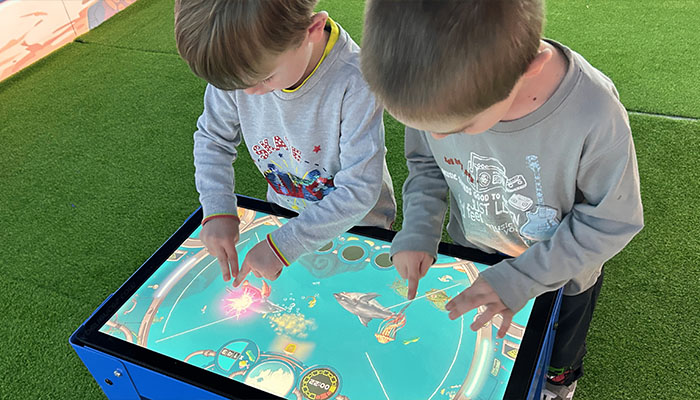
Kahoot
An essential tool. With its dynamic quizzes and instant rankings, Kahoot! energises revision and encourages interaction. It is used in over 200 countries and boasts over 9 billion cumulative participants.
Duolingo
With over 74 million monthly active users, Duolingo has become the ultimate model of gamification. Each lesson is short and fast-paced, accompanied by positive feedback, levels, daily challenges and badges.
Minecraft: Education Edition
Used in thousands of schools, this game teaches history, programming, maths and even biodiversity by enabling players to build collaborative projects in a virtual world that offers opportunities for collaboration.
Want to transform learning through play?
At NeoXperiences, we firmly believe that gamification is one of the most powerful drivers of engagement in education. Our interactive solutions are designed to meet the needs of teachers and students. Through games that allow physical exercise without even realising it and educational games such as ABAKUS.
OUR LATEST NEWS
What is gamification for education? Gamification is a method that borrows concepts from games and integrates them into serious contexts, such as …
What is gamification? Gamification is the art of incorporating game elements into a non-game context. It relies on mechanisms such as challenges, …
In a world where digitalization is transforming every sector, sports clubs must innovate to capture and retain the attention of their members. …
